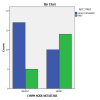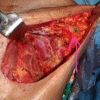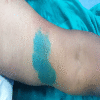Reverse Axillary Mapping in Breast Cancer Using Blue Dye: A Tertiary Setup Experience
- PMID: 34760419
- PMCID: PMC8571997
- DOI: 10.7759/cureus.18576
Reverse Axillary Mapping in Breast Cancer Using Blue Dye: A Tertiary Setup Experience
Abstract
The concept of reverse axillary mapping originated with the main purpose of reducing lymphedema. In this study, we test the advantage of reverse axillary mapping to delineate the arm-draining lymph nodes and their involvement in various stages of breast carcinoma. In this study, we also attempt to redefine the template for axillary dissection in breast cancer. During the period of September 30, 2020, to August 30, 2021, 46 patients were recruited to undergo a procedure in which isosulfan blue dye was injected into the upper arm and the axilla was explored to isolate the lymph nodes. The lymph nodes were submitted for examination histopathologically. The results conclusively showed that axillary lymph node metastasis was only influenced by the advanced stage of the disease (p=0.014) and the visualization of the lymphatics was independent of the stage, type of surgery, decubitus, or age. The study conclusively shows that attempts to preserve the upper limb-draining nodes in advanced stages would be futile and the preservation of such lymph nodes should be limited to the early stages of breast cancer.
Keywords: blue dye; breast cancer research; general surgery and breast cancer; india; reverse axillary mapping.
Copyright © 2021, Narasannaiah et al.
Conflict of interest statement
The authors have declared that no competing interests exist.
Figures




Similar articles
-
Axillary reverse mapping: Is it feasible in locally advanced breast cancer patients?Breast Dis. 2014 Jan 1;34(4):151-5. doi: 10.3233/BD-140371. Breast Dis. 2014. PMID: 24934169
-
A phase I study to assess the feasibility and oncologic safety of axillary reverse mapping in breast cancer patients.Cancer. 2010 Jun 1;116(11):2543-8. doi: 10.1002/cncr.25096. Cancer. 2010. PMID: 20336790 Free PMC article. Clinical Trial.
-
A Prospective Study to Assess the Feasibility of Axillary Reverse Mapping and Evaluate Its Effect on Preventing Lymphedema in Breast Cancer Patients.Clin Breast Cancer. 2015 Aug;15(4):301-6. doi: 10.1016/j.clbc.2015.01.010. Epub 2015 Feb 19. Clin Breast Cancer. 2015. PMID: 25776198 Clinical Trial.
-
Axillary reverse mapping in axillary surgery for breast cancer: an update of the current status.Breast Cancer Res Treat. 2016 Aug;158(3):421-32. doi: 10.1007/s10549-016-3920-y. Epub 2016 Jul 21. Breast Cancer Res Treat. 2016. PMID: 27444925 Review.
-
Axillary reverse mapping for breast cancer.Breast Cancer Res Treat. 2010 Feb;119(3):529-35. doi: 10.1007/s10549-009-0578-8. Breast Cancer Res Treat. 2010. PMID: 19842033 Review.
Cited by
-
Application of Fluorescence Dye in Combination with Methylene Blue for Axillary Reverse Mapping in Patients with Modified Radical Mastectomy for Breast Cancer.J Oncol. 2022 May 14;2022:2305542. doi: 10.1155/2022/2305542. eCollection 2022. J Oncol. 2022. PMID: 35607326 Free PMC article.
References
-
- Surgical complications associated with sentinel lymph node biopsy: results from a prospective international cooperative group trial. Wilke LG, McCall LM, Posther KE, et al. Ann Surg Oncol. 2006;13:491–500. - PubMed
-
- Axillary reverse mapping for preventing lymphedema in axillary lymph node dissection and/or sentinel lymph node biopsy. Noguchi M. Breast Cancer. 2010;17:155–157. - PubMed
-
- Feasibility of axillary reverse mapping during sentinel lymph node biopsy in breast cancer patients. Casabona F, Bogliolo S, Valenzano Menada M, Sala P, Villa G, Ferrero S. Ann Surg Oncol. 2009;16:2459–2463. - PubMed
-
- Blue dye injection in the arm in order to conserve the lymphatic drainage of the arm in breast cancer patients requiring an axillary dissection. Nos C, Lesieur B, Clough KB, Lecuru F. Ann Surg Oncol. 2007;14:2490–2496. - PubMed
-
- Axillary reverse mapping: mapping and preserving arm lymphatics may be important in preventing lymphedema during sentinel lymph node biopsy. Boneti C, Korourian S, Bland K, Cox K, Adkins LL, Henry-Tillman RS, Klimberg VS. J Am Coll Surg. 2008;206:1038–1042. - PubMed
LinkOut - more resources
Full Text Sources
